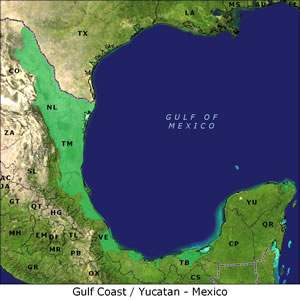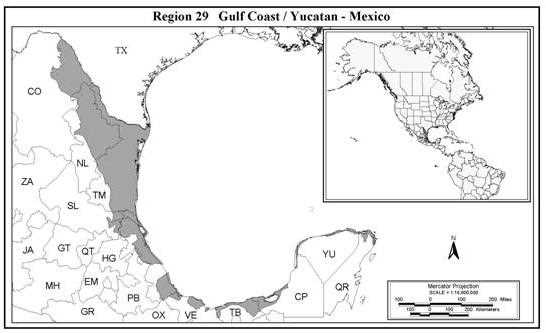Level III Ducks Unlimited conservation priority area, key wintering habitat for redheads and blue-winged teal

Wetlands along the Mexican side of the Gulf Coast of Mexico consist of numerous large complexes of fresh, brackish and salt marshes and mangrove swamps. These areas are negatively impacted by oil drilling, dredging, shipping, agriculture and urban development, as well as natural events such as hurricanes and flooding. There are five wetland areas that make up the most important habitats for wintering and resident waterfowl: Laguna Madre in Tamaulipas; Tamiahua and Alvarado lagoons in Veracruz; Centla Wetlands in Tabasco and the complex of wetlands in Campeche-Yucatan. DU must work in partnership with municipal, state and federal governments and with local and national non-government institutions to conserve the most important wintering habitats for migratory and resident waterfowl.


Wetlands along the Mexican side of the Gulf Coast of Mexico (Region 29*) encompass 2,970 km of littoral wetland habitat. They consist of numerous large complexes of fresh, brackish and salt marshes and mangrove swamps. These areas are negatively impacted by several major human-induced factors (oil drilling, dredging, shipping, agriculture and urban development) and natural events (hurricanes, flooding, etc).
There are five wetland areas that make up the most important habitats for wintering and resident waterfowl: Laguna Madre in Tamaulipas (including the Rio Grande Delta), Tamiahua and Alvarado Lagoons in Veracruz, Centla Wetlands in Tabasco and the complex of wetlands in Campeche-Yucatan.
This hypersaline coastal lagoon encompasses over 200,000 ha of shallow water, flats and shoalgrass beds that provide excellent habitat for several waterfowl species, particularly the redhead. There are 41,975 ha of sea grasses and algae, of which 33,776 ha are monotypic beds of shoalgrass (Carrera and de la Fuente 1994). During the 1970s, the mean biomass of shoalgrass in the Laguna Madre was estimated to be 413.7 g/m2 (Cornelius 1975). Due to lowered salinity caused by construction of permanent channels along the barrier island and other dredging activities, shoalgrass has been reduced by about two-thirds (Mora 1994), with the subsequent reduction of carrying capacity for wintering waterfowl. There are also 36,330 ha of freshwater wetlands that are important to wintering waterfowl along the Laguna Madre (Carrera and de la Fuente 1994).
DU has worked to provide information to support the designation of the Laguna as a Federally Protected Area, but economic interests and development prospects have prevailed with the government of Tamaulipas and the area remains unprotected.
These areas are located in the state of Veracruz and measure 100,000 and 251,661 ha, respectively. Depending on local topography, they are a mosaic of mangroves, tropical flooded deciduous forest, and rain forest. In the Alvarado lagoon, the human population is mainly engaged in fishing activities. Nevertheless, cattle and other agricultural activities have caused the loss of almost all-natural vegetation. The lagoon system still contains vast mangrove communities and shallow lagoons with submerged and floating vegetation. The major threats are pollution from urban developments, sugar cane factories, paper, cellulose and other textile industries, beer factories and tanneries.
Twelve percent of the state of Tabasco is protected as a Biosphere Reserve, which represent the most important freshwater resources in Mexico. The reserve is 302,706 ha; of which 1/3rd is considered to be the nucleus and 2/3rd is a buffer zone. Of the total area, 20% is permanently flooded freshwater delta wetlands formed at the confluence of the Grijalva and Usumacinta Rivers.
Within these two states, three protected areas have been established. Two are state reserves: the Petenes in Campeche and El Palmar in Yucatan, which are 68,000 and 59,177 ha in size, respectively. The third reserve is 85,474 ha and has been designated federally as the Celestun Special Biosphere Reserve in Yucatan. Wetlands of the Yucatan Peninsula are typically long, narrow lagoons inside sand barrier beaches running parallel to the Gulf of Mexico. Yucatan lagoons contain both open water and mangrove swamps that are interspersed with stands of cattails and is a transition zone to upland savannas. These areas contain extensive beds of wigeon grass, shoalgrass, musk grass and turtle grass. Many have been degraded by natural events, mainly hurricanes that created permanent breaches of the barrier island. Human disturbances are characterized by seaports, settlements and roads crossing the coastal wetlands that increase the salinity gradient, which can kill the mangrove swamps, and reducing cover and food supplies to waterfowl.
Ducks Unlimited de Mexico (DUMAC) is currently classifying wetlands of the Yucatan Peninsula, which includes the states of Centla, Campeche, Yucatan and Quintana Roo. This information will be key support for the development of future conservation projects.
The Gulf Coast of Mexico supports 35.2% of the wintering waterfowl in Mexico (DUMAC 1990). The Laguna Madre, Tamaulipas accounts for 18.8% (including the Rio Grande), Tamiahua 3.6% (including Panuco and Tamesi Rivers), Albarado 2.5%, Tabasco 6.9% and Campeche and Yucatan 3.8% (DUMAC 1990).
Waterfowl surveys in 1994 recorded a total of 818,015 ducks and 16,795 geese along the main wintering areas in the Gulf Coast. Of the total ducks reported, 506,600 were dabblers and 311,505 divers. The most abundant species were blue-winged teal (295,785) and redheads 230,075. Between 1991 and 1997 the average number of waterfowl distributed along this area was 649,413 ducks, of which 358,263 were dabblers and 431,273 divers. An average of 23,323 geese was counted during the same period (USFWS 1994).
The Laguna Madre in Tamaulipas, by itself, is a key wintering habitat for 36% of the North American population of redhead. The Laguna Madre in Texas accounts for 41% of the redheads and the rest of the Gulf Coast held 23% during between 1980-94 (Woodin 1996). The Tabasco, Campeche and Yucatan Lagoons are key wintering habitats for the blue-winged teal, holding 44.8% of the waterfowl distributed along the Gulf Coast (USFWS 1997).
*Region 29 - NABCI Bird Conservation Regions 36 & 37 (Mexico only)
173 species of birds are found in this region, which account for 17% of Mexican (Peterson and Chalif 1989). Eighty-one are acquatic, 92 are terrestrial and 46% are migratory. About 1,500 reddish egrets winters in the Laguna Madre This is about 50% of all the species that migrate into Mexico in the fall (Farmer and Carrera 1993). This area is also a key wintering ground for the piping plover. Over 300 individuals have been counted, which represents about 30% of the North American population.
19,071 pairs of colonial birds were reported in these areas by Sprunt and Knoder (1980). Between 30 and 50 species of fish are found in the Tamiahua Lagoon, with between 50-70 species in the Alvarado Lagoon. Out of 647 species of birds in the state of Veracruz, 113 species are aquatic and 534 are terrestrial. Resident species make up 73% of the total and 27 species are migratory.
540 wildlife species have been reported from this area, of which 49% are birds, 19% mammals, 16% reptilians, 14% fish and 2% amphibians. Twelve species are threatened or endangered. The Tabasco wetlands account for 11% of all the aquatic and sub-aquatic vegetation in Mexico. 374 species of 84 families of plants are reported for the area, of which 3 are considered threatened or endangered.
In the Yucatan, 271 species of birds have been recorded, of which 38% are migratory, 14 endemic, 18 threatened and 9 endangered. About 24,000 American flamingos are found in the Yucatan. They are an important tourist attraction for thousands of national and foreign tourists as are four species of cats: panther, cougar, ocelot and jaguar.
For the Campeche area, a total of 1,468 species of wildlife are reported, of which 79 species are protected, either at risk or endangered. The most charismatic species that can be found in the area include the manatee, jabiru, 2 species of crocodiles, and the 4 cat species.
DU must work in partnership with municipal, state and federal governments and with local and national non-government institutions to conserve the most important wintering habitats for migratory and resident waterfowl. The Laguna Madre and the Tamiahua and Alvarado Lagoons are in need of formal protection through legislation or regulation. There are many opportunities to carry out restoration projects on the coast of Tamaulipas and Yucatan. In addition, there is a great need to work with state and federal governments to design roads that cross wetland areas to avoid future wetland loss and to correct past negative impacts.
Along the coastal plain of Tamaulipas, adjacent to the Laguna Madre, freshwater wetlands are key water sources for migratory waterfowl and are in need of protection or restoration. Close cooperation with the cattle industry will be key to the success of these programs.
Baseline wetland classification information is needed to document changes in habitat area and quality and to support future conservation planning. In addition, basic ecological studies of the structure and function of those habitats will provide essential guidance. This information is being gathered for the Yucatan Peninsula.
There are 20,000 ha of rice fields in the state of Campeche in the Edzna and Yohaltoon Valleys that are used by migratory and resident waterfowl. Unfortunately, the agricultural community sustains considerable economic loss (>$1 million/yr) because of waterfowl feeding in rice fields. Many waterfowl are poisoned every year to reduce their impact on the crops. Research is needed to evaluate the real effects of waterfowl on rice to support propose management activities that will minimize damage to both the rice and the waterfowl.
Public awareness will be a key factor in supporting the long-term conservation of wetlands and waterfowl.
Ducks Unlimited uses cookies to enhance your browsing experience, optimize site functionality, analyze traffic, and deliver personalized advertising through third parties. By continuing to use this site, you agree to our use of cookies. View Privacy Policy